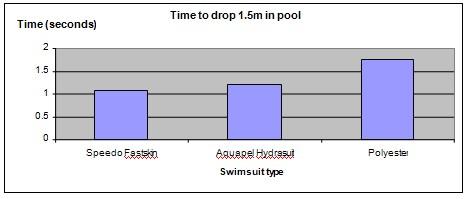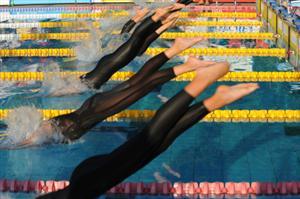| Complexity level: | 8 |
| Project cost ($): | 120 |
| Time required: | 1 hours to prepare, 2 hours for observation |
| Material availability: | Swimsuits may be purchased from a swimming gear retail outlet or department store. Alternatively, you might be able to borrow these from friends. |
| Safety concerns: | Always be careful and aware of the risks of getting/falling into a pool. Adult supervision required. Only swimmers should enter pools. |
Hypothesis
The Speedo Fastskin swim suit should have the least amount of drag and produce the fastest swim speed.
Overview
Swimsuit drag
In modern swimming competitions, records are typically broken by fractions of a second and increasingly the way to win in the swimming competitions is either to be a faster swimmer or to use a better swimsuit.
The swimsuits used in competitive sports are designed to reduce water resistance or drag on the swimmers as they push forward in the water. The drag faced by the swimmer in the water is caused by the body shape of the swimmer and the friction of the water against the skin of the swimmer.
The fast swimsuits which cover most of the athlete’s body are made from two types of materials. A light and soft material is used to reduce the friction between water and skin whereas a stronger material is used to compress and streamline the body shape of the swimmer in order to reduce the water drag.
Scientific Terms
Materials
The materials required for this science fair project:
- A swimming pool at least 1.5meter deep
- A Speedo Fastskin swimsuit
- An Aquapel Hydrasuit swimsuit
- A normal polyester swimsuit.
- 30 kg of sand
- An airtight container large enough to fill the 30kg of sand
- A measuring tape
- A stopwatch
- 1 roll of masking tape
- A qualified swimmer as assistant
Procedure
1. For this experiment, the independent variable is the type of swimsuit used. The dependent variable is the time for the test object (container filled with sand) to reach the pool bottom. This is determined by measuring the time using a stop watch. The constants (control variables) are the weight and dimension of the container, the amount of soil and the depth of the pool.
2. The swimming pool is surveyed and a suitable location is selected where the depth of the pool is 1.5meters.
3. The 30kg of sand is poured into the airtight container . The container is sealed and then wrapped with the Speedo Fastskin swimsuit. The masking tape is used to hold the swimsuit to the container so that it will not fall off during the experiment.
4. The assistant waits in the water with the stopwatch. The container covered with the swimsuit material is placed above the water, just touching the surface. The container is released and the stopwatch started. The assistant will stop the stopwatch the moment the container touches the floor of the swimming pool. The test is repeated 3 times and the times clocked are recorded in the table given below.
5. Procedures 3 and 4 are repeated using the Aquapel Hydrasuit and the normal polyester swimsuit. The tests are also repeated 3 times each and all timings are recorded in the table given below.

Results
It was observed that the Speedo Fastskin swimsuit recorded the fastest time for the container to reach the bottom of the pool and the normal polyester swimsuit took the longest time.
Swimsuit type |
Time taken to drop 1.5 meter in the pool (seconds) |
Average Time (seconds) |
||
Attempt 1 |
Attempt 2 |
Attempt 3 |
||
Speedo Fastskin |
3.224 |
3.189 |
3.205 |
3.206 |
Aquapel Hydrasuit |
3.544 |
3.624 |
3.566 |
3.578 |
Polyester |
5.235 |
5.243 |
5.23 |
5.236 |
The graph below represents the results of our science project experiment.

Conclusion
The hypothesis that the Speedo Fastskin swim suit should have the least amount of drag and give the fastest time is proven to be true.
In the Beijing 2008 Olympics, the legendary Michael Phelps was able to break many records by using modern "fast" swimsuits. The development of new materials that have a lower drag in water compared to the human skin allows the swimmer to have the edge in completing the lap in a shorter time. Modern swimsuits that cover the whole body effectively reduce human skin contact with water and help to compress and reshape the body to reduce water resistance.
Also consider
What would happen if the experiment was repeated using weights of different shapes?
The experiment can also be repeated in seawater.
References
The Y2K swimsuit - http://swimming.about.com/od/swimsuits/a/y2kswimsuit.htm
Fastest swimsuit - http://www.sciencenetlinks.com/sci_update.php?DocID=347

